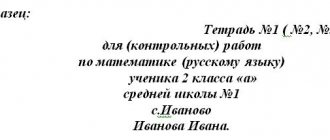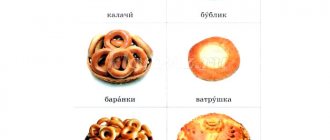Summary of an integrated lesson in Russian language and mathematics with presentation, grade 5
Integrated lesson in Russian language and mathematics for 5th grade students.
Comma in the Russian language and mathematics Russian language: - Today we have an unusual lesson, a lesson in the Russian language and mathematics. Mathematics: - You will work in printed notebooks. Sign your notebook Russian: - You will determine the topic of the lesson yourself if you answer the questions. (Children write down the first letters of their answers, then read their options.) Mathematics: And so, we begin. We write the first letter of the answer in the box on the cover.
- In the fraction 5/100, the number 5 is the numerator, and the number 100 is ... (denominator) - Words of the same part of speech with the opposite meaning ....
(antonyms) – What are fractions in which the numerator is less than the denominator called? (correct) - A letter consisting of two sounds (th) and (a) ... (i) - How can you call the fraction 1/3? (third) - A conjunction that is used in complex sentences and is at the beginning of the alphabet ? (a) - One of the means of communication (language) Mathematics: - What word did you get? Russian language: - In the lesson we will find out why a comma is needed in the Russian language and in mathematics. A comma for semantic understanding of the text 1) Cartoon “In the Land of Unlearned Lessons” - Why is a comma needed? 2) Working with the poem - Vitya Perestukin coped with his task. Having placed the commas correctly, you too will restore the meaning of the poem. Very, very strange view: The river outside the window is on fire, Someone's house is wagging its tail, The dog is shooting from a gun, The boy almost ate the mouse, The cat with glasses is reading a book, The old grandfather flew into the window, The sparrow grabbed the grain and shouted, flying away: - That's what the Comma means! Children read their options
Download Integrated lesson of Russian language and mathematics
Presentation on the topic: Integrated lesson of Russian language and mathematics
Download Workbook Integrated lesson of Russian language and mathematics
We recommend watching:
Summary of a lesson in the Russian language in grade 5. Summary of a lesson in the Russian language in grade 5. Summary of a lesson-game of the Russian language for grade 5. Means of forming UUD for 5th grade students in Russian language lessons.
Similar articles:
Summary of a Russian language lesson in 5th grade. Generalizing repetition
Summary of a Russian language lesson in 5th grade. Indication of softness of consonants in writing
Final test with answers in the Russian language for grades 5-6-7
Summary of a Russian language lesson in 5th grade. Parsing a simple sentence
Summary of a Russian language lesson in 5th grade on the topic: Noun - an amazing part of speech
Forms of knowledge updating and reflection
● Encryption
By solving examples, equations, and problems, students get letters or words and then put them into words or phrases. This form of work arouses interest among schoolchildren, and the only catch is that children begin to guess words after solving only part of the examples. To avoid this, you can scramble the letters from the end, guess a little-known term, or have each student solve their own example by guessing one letter (then the class collects the word together).
If you want to introduce an element of a quest, announce that you received a mysterious message via WhatsApp. Ask: “Guys, help me decipher!” Send the equations via messenger and wait for answers. Having immersed themselves in a familiar digital environment, students get to work faster.
● Triggers
Behind the pictures or pieces of paper with numbers are hidden examples or questions. Children choose which picture they want to look behind. For example, images of camping accessories are given. Invite students: “Let’s choose what we’ll take with us on our hike.” Students take turns or collectively decide which picture to open, and then solve the example hidden behind it. Multi-stage activity is also possible: for example, a student solves an example, finds the answer to the “targets” and opens a theoretical question associated with this “shot”.
● Map
Mark the iconic places with your students, and then play out the resulting route, according to the topic of the lesson. You can attach anything to a map: scale, vector, shapes, straight lines through points, angles of all kinds, etc. Working with a map allows you to immediately capture children's attention with questions about their lives: what museums did you go to? where did you vacation in the summer? Where do you dream of going on a trip?
● Google form
Students receive a link to the Google Form and answer the questions. To update knowledge or reflection, 3-5 tasks are enough. The forms allow you to organize a general anonymous survey to understand how well the class has understood the topic. If you need data for each student, enter the “Name” column and make it mandatory. By the way, in order to avoid test tests, students often pretend that they forgot their phones at home (therefore, they are not distracted by them in class).
● QR code
Students point their phones at a simple black and white icon and receive information: problems and examples, questions, theoretical material. The image itself can be printed and hung on a board or office door, distributed to students, or used in a quest.
Read more in our material: Using QR codes in the educational process. Try the technology for yourself! Here is the code with a link to the Google form example we wrote about above:
● Plickers
– a relative of the QR code. Students receive cards with two-color images and use these cards to answer questions. Through a mobile application, the teacher “scans” the class and instantly “collects” answers and statistics on them. It is impossible to write off, since each image is individual. The application greatly simplifies the lives of teachers, which is why it is widely used. You have to spend time only at the beginning of using the technology, when creating a virtual class.
Algebra. 7th grade. Workbook. At 2 o'clock. Part 1.
The workbook contains various types of tasks for mastering and consolidating new material, developmental tasks, and additional tasks that allow differentiated learning.
Buy
● Crossword
Crossword is a universal tool for cognitive activity. In this form, children can decipher the topic at the beginning of the lesson or repeat the terms at the end of the lesson. Creating a math crossword puzzle is suitable for a teaching project, individual or group.
● Puzzle
By solving examples and answering questions, children gradually reveal an interesting picture. There are many simple online resources for creating and printing puzzles (as well as crosswords).
● “Who Wants to Be a Millionaire”
Design a survey in the spirit of the famous game show and capture the attention of all students - including those who are behind. Even without knowing the answer, the student concentrates on the question, on the correct answer - that is, he masters the material. In addition, working with text surveys contributes to the development of reading literacy.
● “Magic Staircase”
Reflection in the form of the “Magic Staircase” comes from elementary school, but it is also effective in high school. There are many forms of self-assessment and lesson evaluation: in the margins of a notebook, in a virtual survey, in the form of detailed feedback on a virtual board, etc. If a student receives a low grade, expressing dissatisfaction somewhat smoothes out the bad mood and the situation of failure.
"Russian language in mathematics lessons." interesting facts about the Russian language (4th grade) on the topic
Plan:
- X equals x equals.
- Stami?Sta? Stumyu?
- In 1836.
- Alone, or one?
- Symmetry-symmetry.
Our first page is “X is equal to x is equal.”
When reading expressions with variables, many mistakes are made. For example, you can hear: “a is equal to two,” “x is equal to eight.” Today we will focus on the rules for reading literal expressions.
In Russian, the names of the Latin letters x, y, z are masculine, the rest of the Latin letters are neuter. It should be read: “a is equal to three”, “c is equal to minus five”, but “x is equal to three hundred”, “y is equal to one hundred”, etc.
When reading expressions, the names of letters by case do not change:
3u - “three igrek”, not “three igrek”. If the coefficient module is different from 1; 0.1; 0.001, etc., then the expression is read in the plural.
3x=120 – “three X’s equal one hundred and twenty.”
0.8у= -2.4 – “zero point eight y is equal to minus two point four tenths.
The names of all Greek letters in mathematics are usually read in the neuter gender, and they, like the names of Latin letters, do not change by case.
α =30̊ “alpha is equal to thirty degrees”
2 ɣ=180̊ “two gammas are equal to one hundred and eighty degrees.”
The emphasis in the names of all Greek letters, except ώ, (amega), is on the first syllable (alpha, delta, gamma).
Read the sentence:
7.5z= -30 “Seven point five z is equal to minus thirty.”
4р=12.6
m= 7.9
3v=150
ẞ= 45̊
3α=120̊
Correct the sentence:
“Two x’s equals thirty-seven, therefore x’s equals eighteen and five.”
Second page “Stami? Sta? Stamyu?. Why exactly this name, you will find out later.
- Apparently, there is no topic in the Russian language that causes more difficulties than the topic “Numerals”. It is rare to hear, even from radio and television announcers, a multiple-digit number in the oblique case read correctly. In elementary grades, teachers often add the word “number.” “The number 126 is greater than the number 115”, “23 is greater than 15”. But you and I, when we read mathematical expressions, we need to decline the numerals.
-How would you decline the noun hundred?
-So good. You also made mistakes. In one class, having received the same task, students proposed in R.p. option “stam”, in Tp - “stam” and even “stamyu”. But meanwhile, the rules for declension of numerals are not as complex and incomprehensible as they might seem.
-What two groups are nouns divided into?
First, let's look at the rules for declension of cardinal numerals (plates with declension of numerals are distributed). It is easy to decline the numeral “one”. The following cardinal numerals according to the type of declension are divided into several groups, in each of which the case forms of the numerals are similar (all tablets are understood orally). The first group includes numerals from 2 to 4, the second from 5 to 20 and 30, the third from 50 to 80, the fourth 40,90 and 100, the fifth consists of numerals from 200 to 900.
You should pay attention to the coincidence of numeral forms in some cases. Thus, for the numerals 5-20,30,50-80 the forms I.p with V.p, R.p with D.p P.p. coincide. For the numerals 40,90 and 100, even the simplest are 2 forms: in I.p and V.p there is one (forty, one hundred), and in all others, the second (forty, one hundred).
Read:
100-5*20 392-147
40+23 500+210
(4927-3873)*31 735:14
36421:25 850*51
“In the year one thousand eight hundred and thirty-six” or “In one thousand eight hundred and thirty-six.”
When pronouncing the names of numerals, the words “one” and “one” are often omitted. For example, instead of “one million”, “one thousand”, “one billion” they read “million”, “thousand”, “billion”. Instead of “one thousand eight hundred and thirty-six,” they say “one thousand, eight hundred and thirty-six.”
According to the norms of the Russian language, the beginning of the number must be clearly indicated. Therefore, it is incorrect to say “one million two hundred thousand” instead of “one million two hundred thousand”, and in dates together “one thousand” is only “one thousand”.
However, in the middle of the number the words “one”, “one” can be omitted: it is permissible to read the number 1001500 thousand: “one billion million five hundred thousand”.
"One or one."
How to correctly read the expression 1-0.5 “subtract 0.5 from one” or “subtract 0.5 from one”?
The term “one” became widespread in elementary school, when children master the concept of number on the basis of counting various objects. In various mathematical sentences, the name "unit" is more often used. Thus, when reading mathematical expressions, the main term is “unit”. The term “one” is used when counting and naming numbers. You should say: “one pencil”, “one point one tenth”, but subtract 0.2 from the unit; single segment.
"Symmetry-symmetry"
Disputes often arise about the placement of stress in many mathematical terms and the names of scientists. Setting the accent correctly is quite a difficult task. In Russian, the stress can be mobile, for example, game, but games.
A Russian surname can be pronounced with different accents: Ivanov - Ivano; in English, the stress is always on the first syllable: Newton, Maxwell, in French - on the last: Descartes, Viet.
The names of Greek scientists are read with the emphasis on the last syllable: Euclid, Archimedes, Pythagoras, Iron, Thales.
The emphasis in mathematical terms borrowed from other languages is placed in accordance with those accepted in the source language: symmetry (Greek) - axis of symmetry; flyleaf - table on the flyleaf of the textbook.


